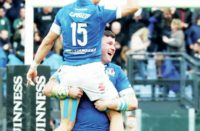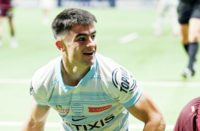 If this autumn series has taught us anything as England attempt to turn the tide against New Zealand, it is that the All Blacks are in danger of devaluing international rugby's currency to the extent that watching them waltz to yet another win is becoming as interesting as watching a kettle boil.
If this autumn series has taught us anything as England attempt to turn the tide against New Zealand, it is that the All Blacks are in danger of devaluing international rugby's currency to the extent that watching them waltz to yet another win is becoming as interesting as watching a kettle boil.
It is not New Zealand's fault, unless rugby excellence has become a crime. Apart from the occasional act of skullduggery – skull being the operative word in the case of Adam Thomson's boot – the All Blacks are so superior that the game in the British Isles is waiting in quiet desperation for a new Carwyn James or Clive Woodward to inspire players and fan the flames of resistance.
Predictable results are a killer for any pro sport, and the fact that no-one can raise their game to get close to turning over New Zealand on an occasional basis, let alone with some regularity, has turned Test rugby from compelling into a damp squib when the All Blacks are playing. While we can appreciate and praise New Zealand's skill and unrivalled tactical nous, unless someone is putting them to the test – with England next in line on Saturday – then Test rugby starts to lose its appeal.
What the Twickenham crowd, or any international crowd or television audience for a big sporting event craves, is a Ryder Cup-like uncertainty of outcome, and the All Black record against the Home Unions is now tragically one-sided.
Ireland and Scotland are almost in the no-hoper bracket, having not once beaten New Zealand in 100 years of trying, and Wales look so browbeaten by the weight of defeats since their last victory over the All Blacks in 1953 that they appear more in need of a psychologist than a coach when they encounter their black-shirted nemesis in the flesh. What's more, unless something remarkable happens soon to change the world rugby order dramatically, that dismal Celtic record looks as if it will endure for another century.
Of the home nations only England have beaten New Zealand over the last 59 years, but those five wins have been rare ports in a storm, occurring once a decade – in 1973 (in Auckland), 1983 and 1993 – before Sir Clive Woodward's world beaters won twice in short order in 2002 and 2003 (in Wellington) in the build-up to World Cup glory.
Over the same period New Zealand have registered 20 wins over England. Nine of those victories have been meted out in succession since a six-man England scrum kept the All Blacks at bay in Wellington, and although superstitious Red Rose supporters may be hanging onto the thread that once every ten years or so the English spring a suprise on New Zealand, it is frayed to breaking point.
Stuart Lancaster's outfit struggled to make a single clean line-break against a depleted Wallaby side, so for England to win would be a bigger shock than Aussie bush-tucker ‘celeb' Nadine Dorries remaining an MP after abandoning her constituents to munch her way through ostrich ‘rings'.
However, pass the All Black aura and all the other hype surrounding them through a sieve, and distil the essence of England v New Zealand to a sporting contest which pitches 23 professionals on each team against each other, and hope springs eternal. One of the enduring tenets of Rugby Union, whether played at international level or on club or community fields the length and breadth of this country, is that if each player in a team outplays his opposite number they will almost certainly win the game.
The only drawback England face in meeting that criterion is that if you picked a composite team from Lancaster's lot and Steve Hansen's 18-match unbeaten All Blacks then there would not be a single Red Rose player in the starting line-up, and, with the possible exception of scrum-half, not on the bench either.
Up front it is no contest. There was a body of opinion before the Australia game that Dan Cole had emerged as a world-class tight-head, but no sooner does the Leicester man climb up the ladder than he takes a tumble – and last weekend it was the Wallaby loose-head, Benn Robinson, who tripped him up. Cole is not consistent enough at either the set piece or in the loose to be considered the world's best No.3, and, if he wants a benchmark of what he has to achieve, then his All Black opposite number Owen Franks is it.

Elsewhere in the front row England do not have hookers to match the hard-nosed experience of either Andrew Hore or Keven Mealamu, and at loose-head Lancaster has forsaken the opportunity to get his one world class forward on the field by enforcing his French exclusion zone and leaving Andrew Sheridan out. So, Tony Woodcock gets the nod because Alex Corbisiero, Mako Vunipola and Joe Marler do not yet carry the same clout.
Luke Romano and Sam Whitelock are not the most fearsome locks that New Zealand has produced, but they are among the most mobile. Their ability to turn up in support wide out on the flanks, or up the middle, while also doing the set-piece graft, is an important component in New Zealand's quick strike, counter-attacking approach, and England's second row combinations have yet to develop that athleticism.
In the back row the All Black advantage is even more marked, with blindside Liam Messam, No.8 Kieran Read, and ‘Captain Fantastic' Richie McCaw streets ahead of a constantly changing England trio in which Chris Robshaw has been the only fixture since Lancaster took over as head coach following Martin Johnson's resignation. Nothing sums up New Zealand's coaching superiority over England better than their realisation over a decade ago that the IRB's tinkering with the ruck/tackle laws made the role of the openside flanker even more important. All Black coaches have always recognised that the breakdown was by far the main source of possession, and that having an outstanding stealer at No.7, such as McCaw, gave them a huge advantage in that area.
With McCaw as their template, the All Black coaching brains-trust drilled every player to have breakdown skills and savvy, so that their openside flanker was not operating as a lone ranger.
Meanwhile, RFU and Premiership coaches subscribed to the alternative view that size and strength were the main requirements at the new breakdown, and decided to forego openside specialists and replace them with big, identikit back row forwards – often the taller the better, so they offered lineout options – who could slot in at blindside, openside and even No.8.
The upshot is that where New Zealand have a well-balanced combination of aggressive, back row ball-winners led by the brilliant McCaw (6ft 2ins), who can also carry and support in attack – and are destructive in defence, denying the opposition fast ball with their limpet-like tenacity – England are at sixes and sevens. Robshaw and Tom Wood are both good back rowers, but neither of them is an openside in the McCaw mould. The England captain is a handy ball-player but better suited to No.6 because he lacks the New Zealander's pace and scavenging skill, while the rugged 6ft 5ins Northampton flanker is also a classic blindside.
The backline comparisons are equally stark with the New Zealand combinations well bedded-in around Dan Carter, their fly-half fulcrum. If McCaw is a once-in-a-generation forward talent then Carter is his backline equivalent, but New Zealand still managed to win the 2011 World Cup with McCaw on one leg and Carter on the sidelines – and the All Black selectors would still manage to pick a formidable team without them.
Aaron Cruden, Carter's understudy, understands his team's patterns, and, while he's not as robust, he is a No.10 who threatens the line as a runner as well as a distributor, in a way that Toby Flood and Owen Farrell do not.
Aaron Smith is a direct scrum-half with searing pace around the fringes, although England probably have the better bench back-up at No.9 with whichever of Danny Care or Ben Youngs is not in the starting line-up, set against Piri Weepu.
New Zealand's midfield is the ideal blend of muscle and guile, with Ma'a Nonu the inside-centre that Lancaster hopes Manu Tuilagi can develop into by adding offloading skills to his powerhouse repertoire. England have no equivalent of Conrad Smith, the elusive outside-centre who is nicknamed ‘Snakey' by his team-mates, although Jonathan Joseph might eventually fill the role if he gets more exposure.
New Zealand's counter-attacking threat remains as potent as ever with Israel Dagg always ready to bolt from full-back into the attacking line to exploit any gaps. Dagg's understanding with right wing Cory Jane is almost telepathic, and Julien Savea's progress on the left wing has continued apace during the autumn, with the muscular flyer scoring ten tries in his first seven Tests.
However, despite such a rich array of talent, Australia showed in last month's draw in Brisbane that New Zealand are not unbeatable – although making your first-up tackles, competing with beserker intensity at the breakdown, and kicking your goals is non-negotiable.
If England are searching for an example of how New Zealand can be knocked out of their stride they need look no further than Brisbane, or this year's all-Kiwi Super 15 semi-final, when the Chiefs beat a Crusaders side stacked with current All Blacks, including McCaw and Carter.
The Chiefs ripped into McCaw and company, showing no respect for reputations. Their pack, spearheaded by the pugnacious Tongan prop, Arizona Taumalolo, led the way by roughing-up the Crusaders at the breakdown, mostly legitimately. This included dragging away opposition players by the scruff, McCaw included, if they were blocking quick ball.
It was a team effort, but it was also one in which most of the Chiefs players won their individual battles. If England can do the same, Test rugby could get the shot of unpredictability it desperately needs. However, the only way Twickenham will witness a once-in-a-decade day this autumn is if each man in white makes the step from also-ran to world-class by summoning a cold fury for the full 80 and outplaying their New Zealand opposite number.


























